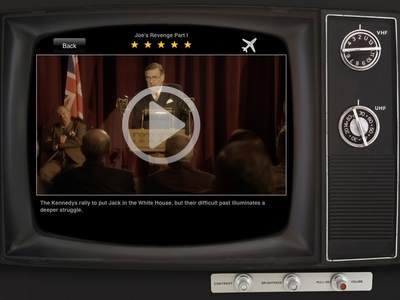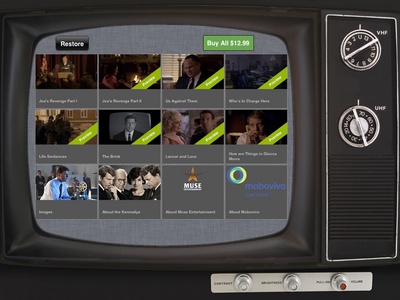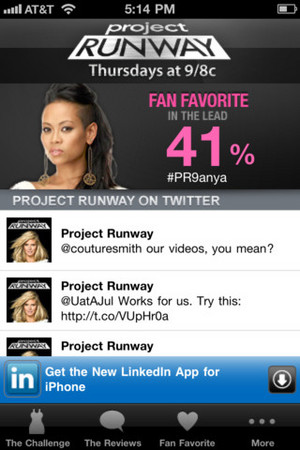On the last day of the History Makers International conference, a three-day event consisting of award presentations, panel discussions, and master classes for producers and broadcasters, a particular tweet caught my eye: “At third screen panel at history conference. I feel like a dinosaur.”
The faster-than-the-speed-of-light changes in the digital world may be making many people feel like dinosaurs, but as Chris Pfaff, moderator of The Third Screen panel and vice chairman of the Producers Guild of America New Media Council, rattled off statistics, (including that the app market is now a $17.5 billion industry) it was clear that networks and content producers are in danger of becoming fossils if rolling out a mobile app isn’t in their near future.
Talking about apps, Pfaff said, “The age-old question was always, ‘But can it make money?’ But now the question is, ‘How much money can it make?’ Before it was, ‘Interactive television is right around the corner,’ but no one has said that in the last year or two, which means, it is here.”
Mobile apps are helping make this interactivity a reality, and audiences are responding by buying devices and downloading in unprecedented numbers. The statistics of this 2011 holiday season were impressive.
According to Flurry, one of the leading mobile analytic companies:
On Christmas day, activations jumped to more than 6.8 million, a 353% increase over the baseline. Compared to Christmas day 2010, the previous single-day record, with 2.8 million device activations, Christmas 2011 grew by more than 140%.
Fiksu, a mobile marketing company, shared these stats:
In December, the (App Store Competitive) Index peaked at 6.04 million downloads per day, beating November’s previous all-time high of 5.65 million daily downloads — a 7 percent increase and the third straight month of increasing app traffic.
Many will argue that apps are the future. Even Wired announced rather controversially last year, “The Web is Dead…” referring in part to the rise of the app.
two-fold value
Mobile apps are proving not only to be profitable but invaluable in building brand loyalty for programming of all kinds.
At its best, historical and non-fictional programming is not only entertaining but educational, helping us learn from both the mistakes and successes of the past and others. Engagement is key in both education and audience building. For networks and content producers, non-fiction and historical programming must be engaging and entertaining in order to be profitable. The apps created around shows become an integral part of enhancing the viewer’s experience, or as Pfaff began the Third Screen panel: “Despite the panel’s title, mobile devices may actually be the primary screen for many audiences.”
The panelists’ case studies presented an interesting look into the app market in general as well as provided a look at how award-winning apps are produced. The Civil War Today, the A&E app, was acclaimed not only in the press but also on education blogs and websites. One home schooling blog pointed out, “At $7.99 it’s less than the price of a paperback and definitely more interactive and engaging.” The Kennedys, an app developed by Mobovivo, also fits neatly into the historical category.
Other case studies at the panel, such as OxygenLive for the Oxygen network or Decoded by Jay-Z created by Fuzz Productions for Random House around a Jay-Z book, may not be strictly categorized as historical or educational, but they’re geared toward younger audiences and have implemented interesting strategies that can be applied across the board to more traditional historical or educational apps.
CASE STUDIES:
Evan Silverman, senior vice president of Digital Media at A+E Networks, spoke primarily on A&E’s immersive iPad app, The Civil War Today:

With a budget in the low six figures, A&E developed an immersive iPad app called The Civil War Today. An immersive app is self-contained and doesn’t need a supplemental screen or additional content to achieve its entertainment and interactivity goals. Silverman emphasized that he didn’t want to rehash all the information already existing about the Civil War. He wanted to take advantage of the iPad’s unique storytelling capabilities. He felt one of the failings of the magazine industry has been regurgitation of the print magazine onto the iPad without offering a unique and rewarding experience for iPad users. The Civil War Today is an app that runs for four years starting 150 years to the day of the start of the Civil War. Each day, iPad users can read a newspaper in real time to experience what happened on that day during the Civil War.
One of the discussions Silverman and his team had was how to price the app. They decided on $7.99 as a single purchase price, a figure that worked out to less than a penny a day. Silverman confirmed that the app has been profitable, but even more importantly, has served as an important brand enhancement opportunity and helped build a relationship with Apple for the network.
Jennifer Kavanagh, senior vice president of Digital at Oxygen, explained OxygenLive, a second screen app used across the network for all the Oxygen programming:

Kavanagh emphasized in her presentation that second screen experiences need to create an authentic reward for their audiences. Second screen apps are defined as applications that enhance the primary viewing experience, which in most cases is television programming, by creating interactive experiences on devices including smartphones and tablets.
Footage scraped off the cutting-room floor isn’t going to keep audiences loyal, Kavanagh stated. OxygenLive is about providing well-edited, exclusive scenes and behind-the-scene interviews. Oxygen integrated into its app Shazam, a popular free app that most younger audiences were already familiar with that allows for audio sampling to cue further interactions.
With OxygenLive, audiences can watch the show live. Kavanagh pointed out that whether you call it co-viewing, transmedia or second screen, the app acts as an “agreement” — a way for an audience to get close to celebrities in exchange for additional time spent with sponsors’ messages. A prime example of this was on premier night of the “Tori & Dean” show, OxygenLive was in bed with Tori and Dean watching the show together live. Live viewing is how a network makes the most money, and OxygenLive helps drives audiences to watch live and not time shift. The app is able to serve the dual purpose of forwarding a business objective while giving the audience a construct where they can benefit and be rewarded, thus creating brand enhancement. OxygenLive is free to download.
Bradley Glenn, mobile producer at Fuzz Productions, shared insights into how to develop successful immersive and second screen apps:
Glenn began his presentation with some specifics about usage, namely this nugget: Smartphone users spend 60 percent of their time with utility apps and 40 percent with entertainment apps. This ratio is reversed on the iPad.
Glenn emphasized that knowing how you want to engage an audience is the priority when developing apps. Content is secondary in many ways, the wireframe being the script. The Decoded by Jay-Z app uses an iTunes tracking feature that goes into a user’s iTunes to see if a Jay-Z song decoded in the app is already on the device. If it is, it can import the song from iTunes into the app or make a suggestion to the user to purchase the song.
Fuzz Productions’ second screen apps include two that are focused on special live-broadcast television events. One is The Hollywood Reporters’ “Race to the Oscars” app and the “NFL Preplay” app. Both are free to download and allow users to interact in real time with other fans with the goal of building community and driving audiences to watch the events when televised rather than in a time-shifted mode. Glenn also demonstrated an immersion app, Pat LaFrieda’s Big App for Meat, that promotes NYC area celebrity butcher Pat LaFrieda while educating its audience on the finer points of meat.
Trevor Doerksen, CEO and founder of Mobovivo, discussed The Kennedys app and older programming getting a second life through apps:
(Note: Chris Geddes of Mobovivo was originally scheduled to participate in the panel but was unable to attend. I was able to catch up with Mobovivo’s founder via email to share what they were going to present at History Makers International.)
Doerksen compares Mobovivo to Netflix, in that it publishes entertainment apps that allow end users to view film and TV on mobile devices, tablets and television. Mobovivo’s apps include secure access to TV and film and allow content viewing when not connected to the Internet. The company’s “Previiw” engine feature allows users to share clips of their favorite films and TV shows with their friends legally as a social, community-building feature. The Kennedy’s app was green-lit after the mini-series’ broadcast window, but Doerksen said Mobovivo often works with filmmakers and producers during the script-writing stages because the iPad has become that important in today’s market.
Many movies and TV shows are out in front of this trend, but Doerksen reminded me that many others are taking advantage of the distribution benefits app provide even for brands with older programs. One app Mobovivo created was for Elvira, and Doerksen pointed out that he didn’t think there was a film newer than 1970 in the app. He summed it up by saying that even older programming looks good on new devices and that demand will only increase as apps become part of the storytelling process.
The Kennedys app is not technically second screen as its focus is on watching episodes on the second screen device, but if it had been developed before the mini-series aired, then the app wouldn’t have included the episodes. After broadcast, the videos would have been made available, adding additional value to the app. Doerksen uses the term “unlimited shelf space” to explain an app’s ability to expand and add new content. Doerksen feels that fans of non-fiction and historical programming are excited about knowledge and entertainment, which means they are interested in the interactive features that allow them to look at shooting locations, character profiles, and of course background on a subject matter, family tree, and other interesting facts. Apps let users satisfy their curiosity instantly, he said, because it’s not just sports fans who like to look up stats while viewing. He said that educators have told him that they use The Kennedys app in their classrooms.

The Kennedys iPad screen, courtesy of Mobovivo.

A new age of interaction, monetization
Kavanagh, Glenn and moderator Pfaff were able to sit down after the panel to extend the Third Screen panel discussion.
Kavanagh brought up a good point by explaining that while they hope that OxygenLive increases live viewing, they’re realistic about the realities of time-shifted viewing. Apps serve other purposes for Oxygen. She explained that the delineation between what is a sales or a marketing initiative and what is purely a digital initiative has completely blurred. Apps allow the audience to deepen their relationship with the show, the brand, and create awareness, all things that are key beats for marketing. But at the same time, Oxygen is able to successfully monetize the apps. They don’t charge to download the app but sell sponsorship opportunity to brands around the apps. Oxygen uses a 360-degree approach, encouraging brands to buy online, VOD (video on demand), or explore other sponsorship opportunities, not just sponsor the program, allowing them to successfully recoup the costs of the apps and create as many wins as they can.
The conversation often swung back to interactivity. The example of Lifetime’s “Project Runway” Fan Favorite app, where a Twitter hashtag appears next to the designers’ names on the television show — allowing views to vote in real time — is a form of interactive television. Kavanagh added that any comments on social media platforms made through the OxgenLive app automatically have the show’s hashtag added to it. This all adds up to more visibility and awareness of a show or brand. Companies like Mass Relevance are letting networks know exactly when and how fans are interacting with their shows. In the past, any kind of interactive live television event would involve a ton of producers, studio time and a huge price tag.

Glenn stressed that the big thing apps give content producers is an opportunity to make money. “Take a long view of this thing. From 1997 through 2008 you had to put content online for free. There was no way around it; no one would pay for anything, and this was very frustrating for broadcasters and independent producers.” (Except for porn and horoscopes, Pfaff reminded the group to a round of laughter.)
“Enter the first Apple Store,” Glenn said. “True, most apps are free, but you created a universe where you can pre-pay for specific experiences — so you are still online, but you are paying to be online.”
The New York Times being free and now charging is a major example of the influence apps have had on the digital marketplace.
Another thing everyone agreed on was that everyone wants a piece of television. Kavanagh said, “You can’t name a media company right now that isn’t in the war room; if they haven’t already publicly shared their road map around television, that isn’t thinking about the future being rooted in television or whatever television becomes.”
Historical and non-fiction programming is going to see a rich future of innovative apps. Apps, unlike almost any other medium used to present content, do not end when created. The app you buy today will change and develop over time, growing more interactive as devices evolve. The social media elements in apps allow students and fans not only to interact with classmates and friends but with people around the world.
There’s no limit to the creative storytelling and educational features that fully developed immersion and second screen apps can bring, taking history and learning out of the classroom and into the living room, the airplane, the waiting room, the bathtub — basically, anywhere we, dinosaurs included, go.
Amanda Lin Costa is a writer and producer in the film and television industry. She writes a series called “Truth in Documentary Filmmaking” and is currently producing the documentary, “The Art of Memories.”


